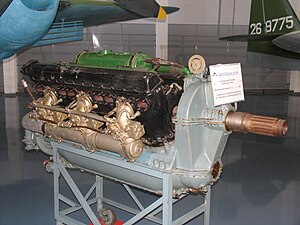Klimov M-105
| M-105 | |
|---|---|

| |
| A VK-105PF engine in Central Air Force Museum (Moscow) | |
| Type | V12 |
| National origin | Soviet Union |
| Manufacturer | Klimov |
| First run | 1938 |
| Major applications | LaGG-3 Petlyakov Pe-2 Yakovlev Yak-1 Yakovlev Yak-9 |
| Number built | c. 129,000 |
| Developed from | Klimov M-103 |
The Klimov M-105 was a V12 liquid-cooled piston aircraft engine used by Soviet aircraft during World War II.[1]
Development
The M-105, designed in 1940, drew heavily on Klimov's experience with the Hispano-Suiza 12Y (license-built as the M-100). In addition to a two-speed supercharger, the M-105 had several improvements like two intake valves per cylinder and a counterbalanced crankshaft. The M-105 was the first Klimov V-12 engine design to place the induction system on the outside of the cylinder banks, with the exhaust system also exiting from the outboard side, with twin sets of "siamesed" exhaust ports adjacent to each other. About 129,000 M-105 and its variants were built.
During the war, Klimov's engines were redesignated from "M" (for "motor," engine) to "VK" for the lead designer's initials.
Variants
- M-105 - (1,100 horsepower (820 kW)) First version produced at the end of 1939. Installed on some pre-war fighters.
- M-105P - (1,050 horsepower (780 kW)) First mass production engine (1940). Able to accept an autocannon in the "vee" between cylinder banks. Installed on the majority Soviet pre-war fighters - Yak-1, LaGG-1 and several experimental aircraft.
- M-105PA - (1,200 horsepower (890 kW)) Improved 1941 version.
- M-105PF (VK-105PF) - (1,260 horsepower (940 kW)) 1942 Modification with significantly increased power output at the expense of decreased high-altitude performance. In spite of Klimov's concerns about decreased service life, the engine was pressed into production at the insistence of Yakovlev, and further exploitation of "PF" version showed this was the right decision. The "PF" was installed on the most numerous versions of "Yak" fighters - Yak-1B, Yak-7B, Yak-9.
- VK-105PF2 & PF3 - (1,300 to 1,360 horsepower (970 to 1,015 kW)) Further increase in power output, which was believed to have exhausted the potential of the M-105 design for greater performance. The "PF2" was installed in the Yak-3.
- M-105PD - (1,170 horsepower (870 kW)) Engine with 2-stage E-100 turbocharger, experimental high-altitude version, unsuccessful prototype.
- M-105R - (1,100 horsepower (820 kW)) Decreased propeller reduction gear ratio for bomber aircraft. Installed on Pe-2, BB-22 (Yak-4) and others.
- M-105RA - (1,110 horsepower (830 kW)) M-105PA with decreased propeller reduction gear ratio for bomber aircraft.
Applications
- Arkhangelsky Ar-2
- Ikarus S-49
- Lavochkin-Gorbunov-Goudkov LaGG-1
- Lavochkin-Gorbunov-Goudkov LaGG-3
- Mörkö-Morane
- Petlyakov Pe-2
- Petlyakov Pe-3
- Yakovlev Yak-1
- Yakovlev Yak-2
- Yakovlev Yak-3
- Yakovlev Yak-4
- Yakovlev Yak-7
- Yakovlev Yak-9
- Yermolayev Yer-2
Specifications (VK-105)
Data from [2]
General characteristics
- Type: Twelve-cylinder liquid-cooled 60° V12 engine
- Bore: 148mm (5.826 in)
- Stroke: 170mm (6.693 in)
- Displacement: 35.101 Liters (2,142.2 cu in)
- Length: 2,027 mm (79.8 in)
- Width: 777 mm (30.59 in)
- Height: 945 mm (37.20 in)
- Dry weight: 575 kg (1,266 lb)
Components
- Valvetrain: Two intake valves and one sodium-filled exhaust valve per cylinder actuated via a single overhead camshaft per bank. Valve lift: 13 mm (intake and exhaust)
- Supercharger: Gear-driven two-speed centrifugal type compressor. Gear ratios: 7.78:1 (1st speed) 11.0:1 (2nd speed). Maximum boost for take-off: 965 mm Hg (38.00 MP), subsequent variants had 1,100 or 1,200 mm Hg. Maximum boost at altitude: 920 mm Hg (36.22 MP), subsequent variants had 1,100 mm Hg. Emergency boost (maximum 2 minutes): 1,100 mm Hg (43.30 MP) at 2,800 RPM. Critical altitude: 2,000 m (6,561 ft) at 1st speed, 4,000 m (13,123 ft) at 2nd speed.
- Fuel system: Six K-105 Carburettors (License copy of Solex-Hispano 56SVC self-adjusted carburettor), three on each "outboard" side of cylinder banks
- Fuel type: 94 (minimum grade), 95 or 100 octane rating gasoline.[3]
- Cooling system: Liquid-cooled
- Reduction gear: 1: 0.666 (1: 0.591 for M-105R)
Performance
- Power output:
- 1,100 hp (820 kW) at 2,700 RPM for take-off, boost rated at 1.27 Atm (38.00 MP)
- 1,050 hp (782 kW) at 2,700 RPM at 13,123 ft (4,000 m), boost rated at 1.21 Atm (36.22 MP)
- 500 hp (372 kW) at 2,700 RPM at 31,168 ft (9,500 m)
- Specific power: 23.36 kW/L (0.513 hp/in³)
- Compression ratio: 7.0:1
- Specific fuel consumption: 328 g/(kW•h) (0.54 lb/(hp•h))
- Oil consumption: 11 g/(kW•h) (0.28 oz/(hp•h))
- Power-to-weight ratio: 1.42 kW/kg (0.86 hp/lb)
See also
Related development
Comparable engines
Related lists
References
Notes
- ^ Gunston 1989, p. 90
- ^ Valtion Lentokonetehdas (1943). Hispano-Suiza 12Y-31, M-103, M-105. Rakenneselostus, Käyttö – Ja Huoltoohjeet ["Valtion Lentokonetehdas" State Aircraft Factory: Hispano-Suiza 12Y-31, M-103, M-105. Use and Maintenance Instructions.] Helsinki: Maintenance and spare technical manual of the Finnish Government. The National Library of Finland.
- ^ During the war, the Soviet Air Force used fuel mixtures, including automotive gasoline, without troubles.
Bibliography
- Gunston, Bill (1989). World Encyclopedia of Aero Engines. Cambridge, England: Patrick Stephens Limited. ISBN 1-85260-163-9.
- Kotelnikov, Vladimir (2005). Russian Piston Aero Engines. Marlborough, Wiltshire: Crowood Press. ISBN 1-86126-702-9.
